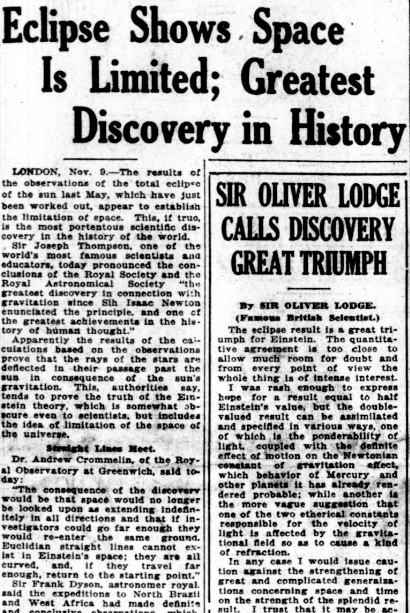
Eclipse as seen on Principe. Wikipedia photo.
Today marks the 100th anniversary of the eclipse of May 29, 1919. The total solar eclipse, which darkened the skies over a band from South America to Africa, had the distinction of having the longest totality (6 minutes 51 seconds) of any since 1416.

Einstein in 1921. Wikipedia image.
But the eclipse was most notable as making possible an experiment that demonstrated one of the predictions of Albert Einstein‘s General Theory of Relativity published in 1915. The gravitational pull of a large object (such as the sun) would bend light waves passing close by, and Einstein predicted how large the effect would be. He noted that a solar eclipse would be the perfect opportunity to prove or disprove the theory, since stars close to the sun would be visible. Their “correct” location in the sky was known. If they could be observed in the “wrong” location, then the measured location would confirm his theoretical findings.
The first attempt was done in conjunction with the eclipse of August 21, 1914. An expedition made up of German and U.S. astronomers traveled to Crimea to observe the eclipse. Unfortunately, Germany declared war on Russia on August 1. The German scientists were either sent home or taken prisoner. The U.S. astronomers were not detained, but clouds prevented the necessary observations.

Dyson (left) and Eddington (right). (Photo credit.)
The 1919 eclipse was the next opportunity, and an experiment was organized by British astronomers Frank Watson Dyson and Arthur Stanley Eddington. This came to be known as the Eddington experiment. Rather than place all eggs in the same basket, as happened in Crimea, the 1919 experiment would have observations taken at two sites: Sobral, Brazil, and the island of Principe off the west coast of Africa.
In Principe, even though clouds obscured the sun until shortly before the eclipse, the team was able to make several photographic plates, one of which showed the background stars clearly enough. The positions did confirm Einstein’s predictions.
While the scientific community was slow to fully accept the findings, the popular press jumped on board, and Einstein’s name became a household word as a result of the experiment. The news clipping below, for example, calling the experiment “the greatest discovery in history” appeared in the Washington Times on November 9, 1919.


Pingback: Allgemeines Live-Blog ab dem 29. Mai 2019 | Skyweek Zwei Punkt Null